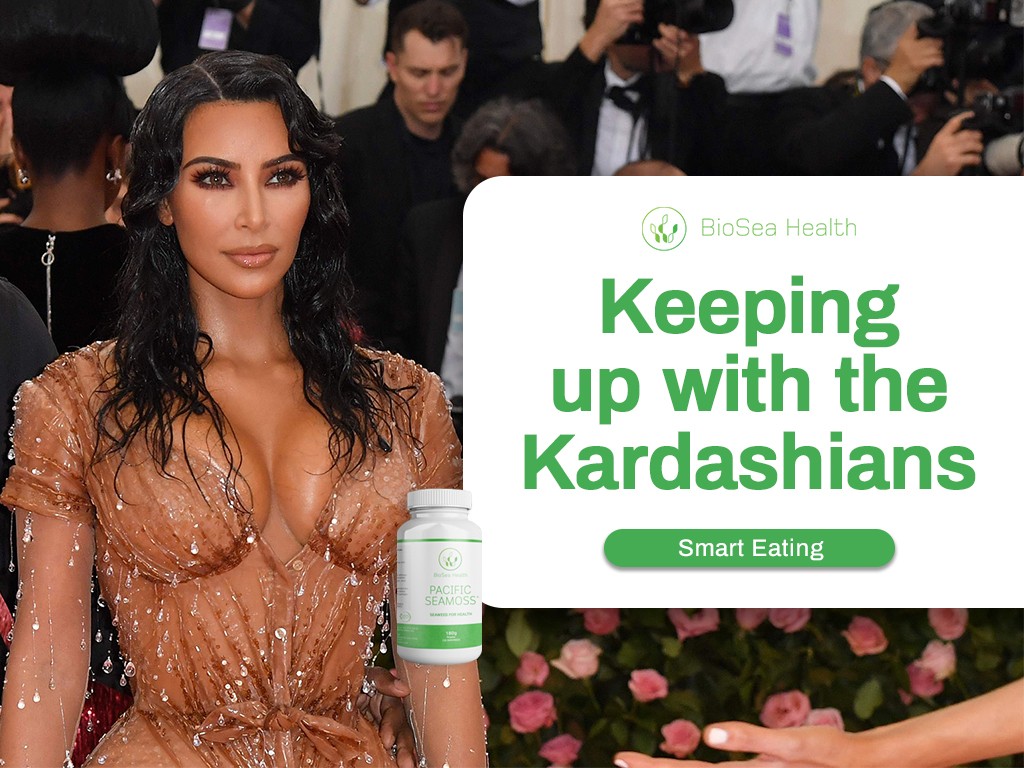Were you aware the Kardashians eat seaweed. Do you care? The internet lit up this week with news that Kim Kardashian sprinkles seamoss in her morning smoothie.
Fans from around the world have flooded search engines and online retailers in a frenzied attempt to learn more about seamoss. So, is seamoss just the latest fad or is Ms Kardashian onto something backed by science?
Kardashians eat Seaweed, and Diet is Backed by Science
Seamoss (or seaweed) has been a staple in the diet of coastal people for millennia and its health effects have been noted for just as long. In recent times, as the western diet has become widespread and lifestyle diseases are impacting national health budgets on an unprecedented scale, science has turned to traditional food sources to find where it all went wrong and how it can be fixed. Seamoss has emerged from the scientific community as a highly regarded functional food; namely a food that has medicinal properties as well as being high in nutrition and prebiotic benefits[1].
Australians Leading Seaweed Research for Food
Australia is one of the leading nations in functional food research. The University of Southern Queensland team, led by Professor Lindsay Brown, has conducted research into the effects of seamoss as an offset to the western high fat high carb diet. The USQ team found that the biological markers of metabolic syndrome; glucose tolerance, hypertension, fatty liver, central obesity; could all be reversed by adding seamoss to the daily food intake[1]. These experiments were done in rats, but earlier trials conducted in Ecuador showed similar results[2]. The key is to have a daily intake of seamoss at a level that keeps the bioactive compounds circulating in the blood stream. In other words, seamoss should be consumed as if it were a medicine.
Beyond metabolic syndrome, there is a great deal of science showing the benefits of having seamoss as a regular part of the diet. Trials examining populations of regular seamoss eaters (such as those Blue Zones of Okinawa) show reduced rates of cancer, cardiovascular disease and neurodegenerative diseases such as dementia[3].
How Does Seaweed Work
So how does seamoss create all these wonderful effects? The main mechanism is the positive change to the ratio of good to bad gut bacteria. Seamoss has been shown to dramatically increase the number of good bacteria, so they pump health enhancing compounds, including short chain fatty acids, into the blood stream. Inflammation is then reduced throughout the body and organs, especially the liver, work more efficiently. Seamoss then creates an epigenetic shift in gene expression, upregulating genes involved in glucose and lipid metabolism[4]. These have effects on the cardiovascular system and the immune system as well as preventing obesity and type 2 diabetes.
In a nutshell, seamoss creates a biological shield against metabolic disease, cancer, cardiovascular disease and the inflammation that causes premature ageing.
It seems like we should all be taking a leaf out of Ms Kardashian’s health book and add seamoss to our daily routines.
References
[1] S. Wanyonyi, R. Du Preez, L. Brown, N. A. Paul, and S. K. Panchal, “Kappaphycus alvarezii as a food supplement prevents diet-induced metabolic syndrome in rats,” Nutrients, vol. 9, no. 11, p. 1261, 2017.
[2] J. Teas, M. E. Baldeón, D. E. Chiriboga, J. R. Davis, A. J. Sarriés, and L. E. Braverman, “Could dietary seaweed reverse the metabolic syndrome?,” Asia Pacific journal of clinical nutrition, vol. 18, no. 2, p. 145, 2009.
[3] A. Nanri et al., “Dietary patterns and all-cause, cancer, and cardiovascular disease mortality in Japanese men and women: The Japan public health center-based prospective study,” PloS one, vol. 12, no. 4, 2017.
[4] Y. X. Chin, Y. Mi, W. X. Cao, P. E. Lim, C. H. Xue, and Q. J. Tang, “A pilot study on anti-obesity mechanisms of Kappaphycus alvarezii: The role of native κ-carrageenan and the leftover sans-carrageenan fraction,” Nutrients, vol. 11, no. 5, p. 1133, 2019.

